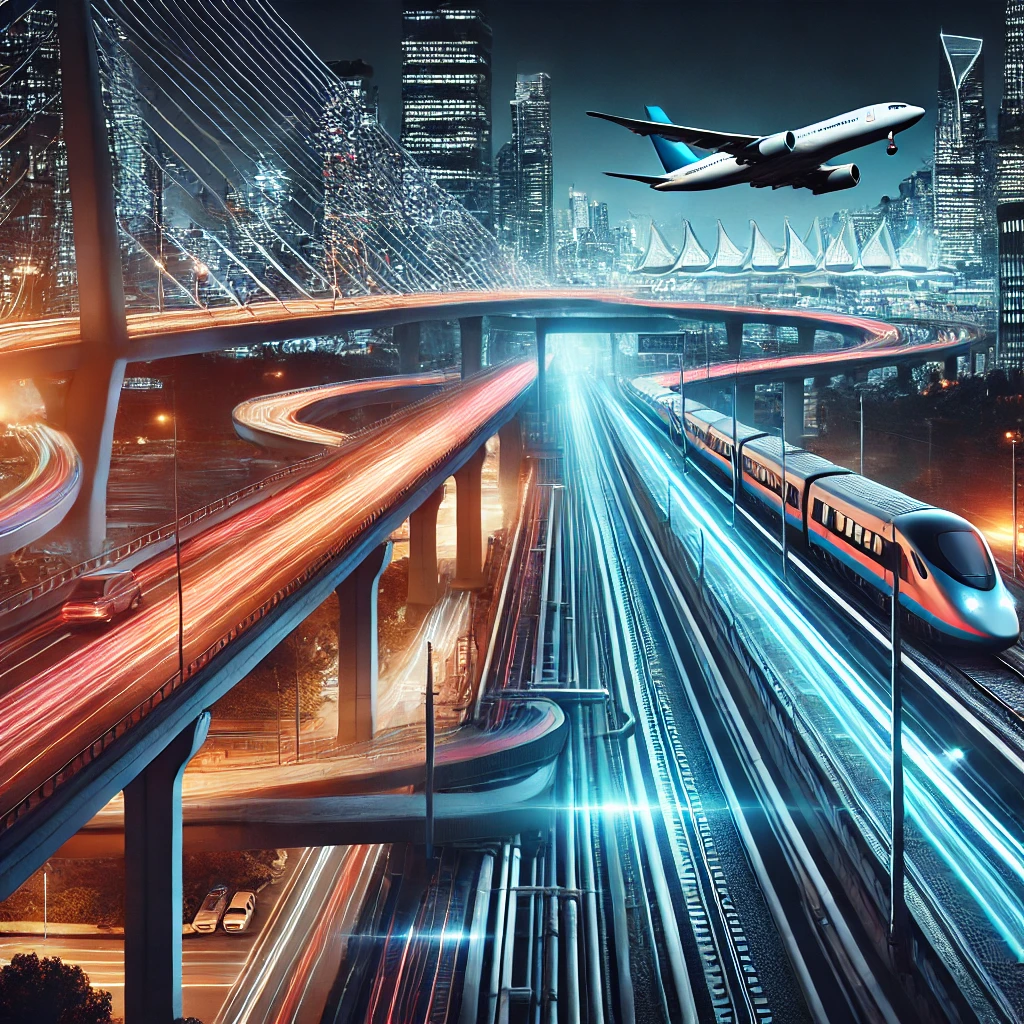Introduction
Transport networks are a crucial component of a country’s economic and social development. They facilitate trade, enhance connectivity, and improve access to essential services like healthcare, education, and employment. In India, an extensive transport infrastructure consisting of roads, railways, airways, and waterways plays a significant role in shaping regional development patterns. However, disparities in transport networks have led to uneven development across different regions, creating socio-economic imbalances.
This article examines the role of transport networks in regional disparities in India, analyzing how their availability, quality, and efficiency influence economic growth, industrialization, and overall human development in various parts of the country.
Understanding Regional Disparities in India
Regional disparities refer to inequalities in economic and social development among different regions of a country. These disparities arise due to various factors, including:
- Geographical constraints (hills, deserts, coastal areas)
- Historical patterns of development (colonial influence, planned development)
- Availability of natural resources
- Government policies and investments
- Infrastructure, including transport networks
Among these, transport infrastructure plays a fundamental role in determining the pace and extent of regional development. Well-connected regions tend to experience faster economic growth, industrial expansion, and higher living standards, while poorly connected regions lag behind.
Role of Transport Networks in Regional Development
Transport networks contribute to regional development in the following ways:
- Facilitating Trade and Commerce
- Enhancing Industrial Growth
- Improving Agricultural Productivity
- Boosting Tourism and Services
- Providing Access to Social Infrastructure (Healthcare and Education)
- Generating Employment Opportunities
When transport networks are underdeveloped or inefficient, these benefits do not reach all regions equally, leading to disparities.
Types of Transport Networks and Their Impact on Regional Disparities
1. Road Transport and Regional Disparities
Road transport is the most widely used mode of transportation in India, accounting for nearly 85% of passenger movement and 60% of freight movement. National highways, state highways, and rural roads form the backbone of connectivity.
Impact on Regional Disparities:
- Well-connected states like Maharashtra, Gujarat, Tamil Nadu, and Karnataka have extensive highway networks, boosting industrial growth and urbanization.
- Poorly connected states like Bihar, Jharkhand, and parts of the Northeast struggle with inadequate roads, limiting economic opportunities.
- Rural-urban divide: Many villages in remote areas lack proper roads, restricting access to markets, healthcare, and education.
Government Initiatives to Reduce Disparities:
- Bharatmala Project: Aims to enhance road connectivity across India, particularly in backward regions.
- Pradhan Mantri Gram Sadak Yojana (PMGSY): Focuses on improving rural road connectivity to integrate remote villages into the mainstream economy.
Despite these efforts, states with difficult terrains (Himalayan and tribal areas) still suffer from poor road infrastructure.
2. Rail Transport and Regional Disparities
Indian Railways is one of the largest railway networks in the world, playing a vital role in freight and passenger transport. However, its distribution is uneven.
Impact on Regional Disparities:
- Dense railway networks in industrialized states (Punjab, Haryana, Maharashtra, Tamil Nadu) have facilitated economic growth.
- Sparse railway networks in underdeveloped regions (Northeast, tribal areas, parts of Rajasthan) have hindered industrialization and mobility.
- Metropolitan vs. rural contrast: Major cities like Delhi, Mumbai, and Kolkata have well-developed railway infrastructure, while remote regions struggle with poor connectivity.
Government Initiatives to Reduce Disparities:
- Dedicated Freight Corridors (DFC): Aims to enhance goods transport efficiency, benefiting underdeveloped regions by improving logistics.
- Railway Electrification and Modernization Projects: Targeting better connectivity in backward regions.
- North-East Connectivity Mission: Expanding railway networks in the Northeast to integrate the region with the rest of the country.
Despite these initiatives, hilly terrains, insurgencies, and financial constraints limit railway expansion in certain areas.
3. Air Transport and Regional Disparities
Air transport is essential for fast movement of goods and people, particularly in remote and inaccessible regions. However, India’s air connectivity remains highly skewed.
Impact on Regional Disparities:
- Major airports in metro cities (Delhi, Mumbai, Bengaluru, Chennai) promote economic activities and attract investment.
- Smaller towns and backward regions lack proper air connectivity, restricting business expansion and tourism potential.
- High airfare costs make air travel inaccessible for the majority in underdeveloped regions.
Government Initiatives to Reduce Disparities:
- UDAN Scheme (Ude Desh Ka Aam Nagrik): Aims to develop regional airports and make air travel affordable for smaller cities and remote regions.
- New Greenfield Airports: Development in Northeast and smaller states to boost connectivity.
While air transport has improved in some regions, states like Chhattisgarh, Jharkhand, and many parts of the Northeast still lack adequate facilities.
4. Water Transport and Regional Disparities
India has a vast network of inland waterways and coastal shipping routes, but they remain underutilized compared to road and rail transport.
Impact on Regional Disparities:
- Well-developed ports in Gujarat, Maharashtra, and Tamil Nadu contribute significantly to trade and industrial growth.
- Underdeveloped inland waterways in eastern and northeastern states limit economic potential despite the presence of major rivers.
- Limited investment in waterways infrastructure makes it less competitive compared to road and rail transport.
Government Initiatives to Reduce Disparities:
- Sagarmala Project: Aims to modernize port infrastructure and promote coastal development.
- National Waterways Development Plan: Focuses on utilizing rivers for cargo and passenger transport in remote regions.
Despite these efforts, the inland waterways sector needs further modernization to become a viable alternative to road and rail transport.
Challenges in Addressing Transport-Related Regional Disparities
- Geographical Barriers: Hilly and forested regions face difficulties in infrastructure development.
- Financial Constraints: Poor states have limited budgets for infrastructure expansion.
- Policy Delays and Bureaucratic Hurdles: Slow implementation of transport projects affects connectivity.
- Environmental Concerns: Infrastructure development may lead to deforestation and displacement.
- Technological Gaps: Many backward regions lack modern transport infrastructure.
Strategies to Bridge the Transport Gap and Reduce Regional Disparities
1. Strengthening Rural and Tribal Connectivity
- Expanding rural road networks under PMGSY.
- Developing low-cost rail projects for remote areas.
2. Enhancing Rail and Metro Connectivity
- Expanding metro rail networks in tier-2 and tier-3 cities.
- Introducing semi-high-speed and bullet trains to connect underdeveloped regions.
3. Promoting Inland and Coastal Transport
- Developing National Waterways for freight transport.
- Improving port infrastructure in eastern and northeastern states.
4. Private Sector Participation and Foreign Investment
- Encouraging Public-Private Partnerships (PPP) in transport infrastructure.
- Attracting foreign investment in road, rail, and airport projects.
5. Sustainable and Green Transport Solutions
- Expanding electric mobility and smart transport systems.
- Promoting eco-friendly transport policies to reduce carbon emissions.
Conclusion
Transport networks play a crucial role in shaping regional development patterns in India. While well-connected states and urban centers enjoy economic prosperity, backward regions continue to struggle due to poor transport infrastructure. The disparities in road, rail, air, and water transport widen the economic divide, limiting opportunities for millions.
To bridge these gaps, India must invest in comprehensive transport infrastructure development, particularly in remote and underdeveloped regions. By implementing strategic policies, promoting private sector participation, and adopting sustainable transport solutions, the country can achieve balanced regional growth and inclusive development.




